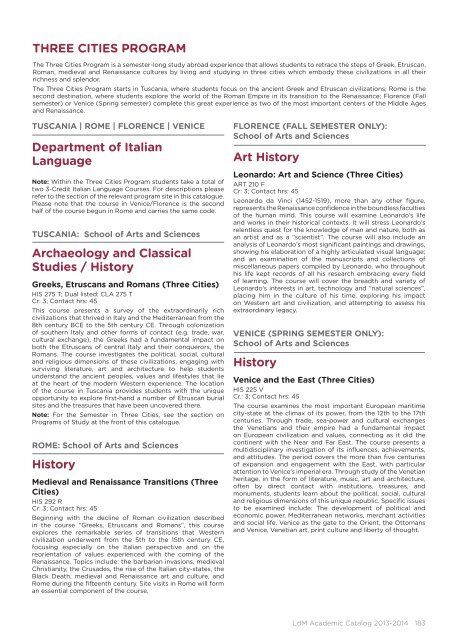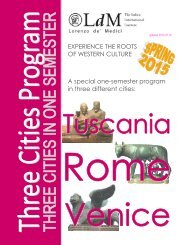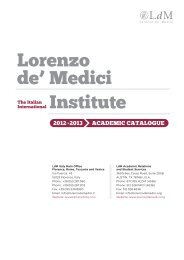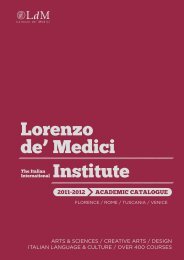aCademiC Catalog 2013-2014 - Lorenzo de Medici
aCademiC Catalog 2013-2014 - Lorenzo de Medici
aCademiC Catalog 2013-2014 - Lorenzo de Medici
You also want an ePaper? Increase the reach of your titles
YUMPU automatically turns print PDFs into web optimized ePapers that Google loves.
THREE CITIES PROGRAM<br />
The Three Cities Program is a semester-long study abroad experience that allows stu<strong>de</strong>nts to retrace the steps of Greek, Etruscan,<br />
Roman, medieval and Renaissance cultures by living and studying in three cities which embody these civilizations in all their<br />
richness and splendor.<br />
The Three Cities Program starts in Tuscania, where stu<strong>de</strong>nts focus on the ancient Greek and Etruscan civilizations; Rome is the<br />
second <strong>de</strong>stination, where stu<strong>de</strong>nts explore the world of the Roman Empire in its transition to the Renaissance; Florence (Fall<br />
semester) or Venice (Spring semester) complete this great experience as two of the most important centers of the Middle Ages<br />
and Renaissance.<br />
TUSCANIA | ROME | FLORENCE | VENICE<br />
Department of Italian<br />
Language<br />
Note: Within the Three Cities Program stu<strong>de</strong>nts take a total of<br />
two 3-Credit Italian Language Courses. For <strong>de</strong>scriptions please<br />
refer to the section of the relevant program site in this catalogue.<br />
Please note that the course in Venice/Florence is the second<br />
half of the course begun in Rome and carries the same co<strong>de</strong>.<br />
TUSCANIA: School of Arts and Sciences<br />
Archaeology and Classical<br />
Studies / History<br />
Greeks, Etruscans and Romans (Three Cities)<br />
HIS 275 T; Dual listed: CLA 275 T<br />
Cr: 3; Contact hrs: 45<br />
This course presents a survey of the extraordinarily rich<br />
civilizations that thrived in Italy and the Mediterranean from the<br />
8th century BCE to the 5th century CE. Through colonization<br />
of southern Italy and other forms of contact (e.g. tra<strong>de</strong>, war,<br />
cultural exchange), the Greeks had a fundamental impact on<br />
both the Etruscans of central Italy and their conquerors, the<br />
Romans. The course investigates the political, social, cultural<br />
and religious dimensions of these civilizations, engaging with<br />
surviving literature, art and architecture to help stu<strong>de</strong>nts<br />
un<strong>de</strong>rstand the ancient peoples, values and lifestyles that lie<br />
at the heart of the mo<strong>de</strong>rn Western experience. The location<br />
of the course in Tuscania provi<strong>de</strong>s stu<strong>de</strong>nts with the unique<br />
opportunity to explore first-hand a number of Etruscan burial<br />
sites and the treasures that have been uncovered there.<br />
Note: For the Semester in Three Cities, see the section on<br />
Programs of Study at the front of this catalogue.<br />
ROME: School of Arts and Sciences<br />
History<br />
Medieval and Renaissance Transitions (Three<br />
Cities)<br />
HIS 292 R<br />
Cr: 3; Contact hrs: 45<br />
Beginning with the <strong>de</strong>cline of Roman civilization <strong>de</strong>scribed<br />
in the course “Greeks, Etruscans and Romans”, this course<br />
explores the remarkable series of transitions that Western<br />
civilization un<strong>de</strong>rwent from the 5th to the 15th century CE,<br />
focusing especially on the Italian perspective and on the<br />
reorientation of values experienced with the coming of the<br />
Renaissance. Topics inclu<strong>de</strong>: the barbarian invasions, medieval<br />
Christianity, the Crusa<strong>de</strong>s, the rise of the Italian city-states, the<br />
Black Death, medieval and Renaissance art and culture, and<br />
Rome during the fifteenth century. Site visits in Rome will form<br />
an essential component of the course.<br />
FLORENCE (FALL SEMESTER ONLY):<br />
School of Arts and Sciences<br />
Art History<br />
Leonardo: Art and Science (Three Cities)<br />
ART 210 F<br />
Cr: 3; Contact hrs: 45<br />
Leonardo da Vinci (1452-1519), more than any other figure,<br />
represents the Renaissance confi<strong>de</strong>nce in the boundless faculties<br />
of the human mind. This course will examine Leonardo’s life<br />
and works in their historical contexts. It will stress Leonardo’s<br />
relentless quest for the knowledge of man and nature, both as<br />
an artist and as a “scientist”. The course will also inclu<strong>de</strong> an<br />
analysis of Leonardo’s most significant paintings and drawings,<br />
showing his elaboration of a highly articulated visual language;<br />
and an examination of the manuscripts and collections of<br />
miscellaneous papers compiled by Leonardo, who throughout<br />
his life kept records of all his research embracing every field<br />
of learning. The course will cover the breadth and variety of<br />
Leonardo’s interests in art, technology and “natural sciences”,<br />
placing him in the culture of his time, exploring his impact<br />
on Western art and civilization, and attempting to assess his<br />
extraordinary legacy.<br />
VENICE (SPRING SEMESTER ONLY):<br />
School of Arts and Sciences<br />
History<br />
Venice and the East (Three Cities)<br />
HIS 225 V<br />
Cr.: 3; Contact hrs: 45<br />
The course examines the most important European maritime<br />
city-state at the climax of its power, from the 12th to the 17th<br />
centuries. Through tra<strong>de</strong>, sea-power and cultural exchanges<br />
the Venetians and their empire had a fundamental impact<br />
on European civilization and values, connecting as it did the<br />
continent with the Near and Far East. The course presents a<br />
multidisciplinary investigation of its influences, achievements,<br />
and attitu<strong>de</strong>s. The period covers the more than five centuries<br />
of expansion and engagement with the East, with particular<br />
attention to Venice’s imperial era. Through study of the Venetian<br />
heritage, in the form of literature, music, art and architecture,<br />
often by direct contact with institutions, treasures, and<br />
monuments, stu<strong>de</strong>nts learn about the political, social, cultural<br />
and religious dimensions of this unique republic. Specific issues<br />
to be examined inclu<strong>de</strong>: The <strong>de</strong>velopment of political and<br />
economic power, Mediterranean networks, merchant activities<br />
and social life, Venice as the gate to the Orient, the Ottomans<br />
and Venice, Venetian art, print culture and liberty of thought.<br />
LdM Aca<strong>de</strong>mic <strong>Catalog</strong> <strong>2013</strong>-<strong>2014</strong><br />
183





